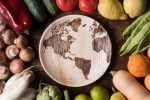Restaurant prices hit an all-time high in January 2025, with a sharp increase from last year. Behind these numbers lies a complex story of import tariffs that affects every plate you serve.
Let’s get specific. A single lemon that cost you something last year now demands more due to tariffs imposed on non-agricultural goods. Your signature guacamole? The avocados changed in price as steel and aluminum imports impact packaging costs. These aren’t random fluctuations – they’re direct results of import tariffs hitting your supply chain, a ripple effect from President Trump’s trade policy.
Here’s what’s happening right now: Restaurant owners across the U.S. face a stark choice. Some are cutting portion sizes to maintain profit margins. Others are raising menu prices in response to threatened tariffs on trading partners like Canada and Mexico. Many are doing both. But there’s a third option that smart restaurant owners are choosing.
The key isn’t just knowing that tariffs affect your business – it’s understanding exactly how they impact your specific operations. Whether it’s border protection measures impacting your imports or unfair practices affecting your costs, staying informed is essential.
This matters because every ingredient on your menu tells a financial story. When tariffs shrink or raise prices, that story changes too. Your imported olive oil, your Spanish wines, your Canadian seafood – each item carries a hidden cost that directly affects your bottom line. As many economists predict, raising tariffs could raise revenues but also raise prices for consumers, which may impact demand.
We’ll examine real numbers from actual restaurants, study proven strategies that work in 2025’s market conditions, and show you exactly how to protect domestic industries while boosting domestic manufacturing. You’ll learn why some restaurants thrive despite rising tariffs while others struggle to stay open.
Most importantly, you’ll get clear, actionable steps to shield your restaurant from future tariff shocks, keeping you ahead of world trade shifts and presidential memorandums that might impact your cost structure.
Metrobi drivers are rated 4.97/5
Trusted by local businesses for:
- Background-checked professionals
- Specialized in business deliveries
- Same drivers for consistency
- 4.97/5 average delivery rating
What is the impact of import tariffs on your restaurant?
Import tariffs mean higher costs for ingredients.
They shake up food prices, affecting restaurant expenses.
Higher costs can erode already thin profit margins in restaurants.
Examples of import tariff impacts
Import tariffs can drive food costs up dramatically for restaurants. Citrus and avocados become more pricey under tariffs, complicating menu planning. With rising costs for these fruits, your expense sheet becomes a place of concern. Restauranteurs can’t ignore changes, as these essentials often appear on a wide range of menus.
The meat experience is no different. Items like beef and seafood also suffer from higher tariffs. The effect trickles down into restaurant operations. You pay more to keep popular dishes featuring these ingredients available. This means calculating whether these dishes stay profitable, leading to difficult decisions about menu adjustments.
Your market choices often revolve around today’s prices. Tariffs add unpredictability, making daily decisions feel uncertain. When costs jump for citrus, avocados, beef, and seafood, you need to be reactive. This requires more frequent reviews of your food cost percentages and proactive strategies on sourcing. To understand how tariffs play a role, consider exploring “Economics of Food Prices” by Colin A. Carter and Giancarlo Moschini for a deep dive into agri-business impacts.
Types of impacts on restaurant supply chain costs
Tariffs play around with costs in two ways. First, direct cost increases make ingredients more expensive. Items come with heftier price tags, changing what you pay immediately. Imported food items like oils and spices suddenly cost more, throwing budgets off balance. Immediate impacts on inventory expenses require restaurants to manage cash flow tighter than ever.
Direct Tariff Costs: Tariffs account for about 0.67% ($0.02) of the $3.27 cost per day for a least-cost healthy diet in 144 countries.
Indirect costs also show up. Suppliers often shoulder more initial costs, adjusting their pricing models to cover the gap. You see a chain reaction—extra costs relocate down the line to you, ultimately impacting overall operational costs. The National Restaurant Association highlights, “When tariffs raise the price of imported food, restaurants may face higher inventory costs. Ingredients such as seafood, specialty oils, or spices may see price hikes.” Increased supplier prices ripple outward, affecting much more than simple ingredient costs.
Domestic Value Added: On average, 83% of the retail price of imported food products is attributed to domestic value added after arrival.
Figuring out whether tariffs help or harm business is tricky. Tariffs can protect local industries but harm those relying on imports. They can put local and international companies at odds, leading to increased tension and potential trade disputes. Businesses suffering from tariffs face increased expenses that are often difficult to pass on to consumers without risking loyalty. Considering both sides requires a nuanced perspective, discussed insightfully in “The Effects of International Trade on Local Labor Markets” by David Autor.
Are tariffs good or bad for business?
Tariffs affect businesses in ways that feel both supportive and punishing. For local producers, tariffs can act as a safeguard against cheaper foreign competitors. For restaurants relying on global imports, they spell out higher cost hurdles in a highly competitive market. The view isn’t always clear-cut. Some argue tariffs preserve local jobs and industries, but businesses deeply intertwined with international supply chains see them as barriers.
The resulting price uncertainty causes headaches for many business owners. As stated in UC Davis Magazine, “When we put tariffs on imported goods, the costs of these tariffs are embedded in the price of what we buy in very complicated ways.” Different sectors experience unique impacts, making it essential for restaurant owners to continuously update strategies based on how tariffs may shift global pricing.
Further reading on the pros and cons of tariffs can be found in the book “The Political Economy of Trade Policy” by Feenstra and Taylor. It offers a detailed view of trade politics and the economic theories behind the discussions.
What is one impact on a business if tariffs are placed on its exports?
If your business exports food, higher tariffs can lower competitiveness abroad. A country placing tariffs on your exports reduces their appeal in foreign markets due to price hikes. As a result, demand can drop, threatening revenue streams and profitability. Retaining market presence demands enhanced efficiency or cost-saving measures to maintain attractive pricing.
Varying Business Impacts: Approximately 30% of all small business owners expect sales to decrease following tariffs, while another 40% expect no impact on sales.
Tariffs thus affect both ends of the business spectrum, influencing how income is generated and how costs are managed. Keeping informed about these shifts is vital for strategic planning. Keep track of policy updates, evaluate supplier relationships, and negotiate where possible to minimize the impact on both fronts.
This all means staying sharp on trends and ready to adapt. Navigating tariffs requires you to be proactive, stretching beyond surface reactions to leverage available resources and knowledge. Aim for a complete understanding, empowering your restaurant to maintain stability and success despite the challenges.
Benefits of understanding tariffs’ impact on profitability
Accurate cost forecasting helps manage budgets.
Pricing adjustments keep menus profitable.
Improved Cost Forecasting
Understanding tariffs means you know which products are going to cost you more. Restaurants operate on very slim margins. Michelle Korsmo, CEO of the National Restaurant Association, mentions that these margins are usually between limited cash reserves. When tariffs increase, having foresight can help you manage budgets effectively before those changes hit your bottom line. Instead of reacting to these costs, you can plan for them, especially when tariffs imposed by President Trump or foreign governments affect import duties.
There’s a wealth of literature focusing on cost forecasting in the restaurant industry. Books like “Pricing Strategies” by Robert Docters can offer insights into more complex budget forecasting methods. For those wanting to get deeper into this topic, studying statistical models used for economic predictions might be worth your time. For instance, time-series analysis is a method used for predicting future trends based on past data. Mastering these techniques can help you fine-tune your forecasts and budget adjustments more effectively as tariff conditions shift due to changes in trade policy or decisions from the World Trade Organization.
Understanding how price changes in your supply chain impact overall expenses is crucial for maintaining profitability. The rise in ingredient costs due to tariffs isn’t just a problem on its own. It’s part of a chain reaction affecting everything from the menu to staffing, and ultimately, the customer experience. Knowing how each part of this system is linked will help you mitigate unexpected financial blows down the line, especially when tariffs affect manufacturing jobs and supply chains. To better manage the complexities of rising costs, utilizing a detailed recipe costing tool can be a game-changer. A comprehensive recipe costing template helps restaurants accurately price menu items by accounting for ingredient cost fluctuations, including those caused by tariffs. Implementing such tools allows you to simplify the pricing process in just a few steps, ensuring your menus remain profitable without sacrificing quality or customer satisfaction. For more insights, check out this helpful recipe costing guide to streamline your pricing strategy.
In addition to recipe costing tools, restaurants can explore strategies to cut overhead and reduce food costs without compromising quality. These tactics include negotiating better rates with suppliers, optimizing portion sizes, and leveraging seasonal and local ingredients to keep expenses manageable. By embracing such cost-saving measures, restaurant owners can protect their profit margins even amidst tariff-induced price fluctuations.
Strategic Menu Adjustments
Strategic pricing on menus is essential. One way to mitigate rising costs is by swapping expensive items with cheaper alternatives. If avocados become more costly due to tariffs, consider using seasonal vegetables as a substitute. This way, you can control costs without sacrificing quality. Subscribers to industry reports like those from Technomic can stay updated on how other businesses strategically adjust their offerings.
There’s a debate worth exploring on whether these adjustments should involve communicating the reasons to customers. Transparency can build trust, but it can also draw attention to higher prices caused by tariffs. Michelle Korsmo notes restaurants can’t just keep raising menu prices to offset higher costs. Alternatives can enhance your menu’s appeal and keep customers engaged. Chefs have long tapped into locally sourced ingredients as a way to lessen dependence on imports, avoiding the impact of tariffs on imported goods.
Delve into food supply chain management literature for further understanding. Books such as “Supply Chain Management for the Curious” by Bradley J. Mott explain how businesses can rely less on tightly linked supply chains. By doing so, restaurants can foster better relationships with a mixture of local suppliers and global suppliers, ensuring a diverse range of options even when tariffs impact prices.
Understanding how tariffs affect your overall strategy allows you to adjust with agility. Flexibility in your menu means that, should tariffs change, your restaurant is prepared to evolve alongside these economic shifts. The anticipation and strategic foresight are essential tools in the management toolkit for any restaurateur who aims to maintain profitability against a backdrop of changing trade policies and economic landscapes.
How does the impact of tariffs on food prices change operations?
Tariffs can lead to temporary supply shortages and higher costs.
Restaurants may need to find new suppliers or alternative ingredients.
Can affect operations by necessitating strategic adjustments.
Step #1: Evaluate Supplier Costs
The first thing is understanding how tariffs affect your suppliers’ costs. Check in with your current suppliers directly. Ask them about any price changes due to recent tariffs. They can give you insights into how these costs have shifted and what you can expect moving forward. This direct communication builds transparency and helps prevent surprises on invoices.
Once you have this information, compare these prices with what other suppliers offer. Look into local alternatives if possible. Local suppliers often have more stable pricing since they aren’t impacted by certain types of tariffs. Think about building partnerships with these local sources for the long term.
Major Canadian Imports: The top three food and beverage imports from Canada total over $12 billion, including baked goods, rapeseed oil, and fresh beef.
Local Sourcing Options
Sourcing ingredients closer to home can be one of the quickest ways to stabilize costs. Local suppliers provide not only steadier pricing but also a way to support nearby businesses.
Step #2: Adjust Menu and Pricing
After pinpointing costly ingredients, determine which menu items are affected. Break down your menu by ingredient cost, highlighting those that have increased the most.
Consider modifying these dishes or replacing expensive items with cheaper ones. Seasonal ingredients can be a good fit, as they are typically more economical during peak times. This doesn’t just save costs but can also introduce variety into your offerings.
Finding Ingredient Alternatives
Switching out expensive ingredients can help keep a menu item viable. Focus on introducing local or seasonal alternatives.
Major Chinese Imports: Top imports from China, including fish fillets, modified fats and oils, and preserved fruits and nuts, total over $2 billion.
5 Strategies for mitigating tariff effects in restaurants
Build partnerships with local suppliers
Reduce the restaurant’s reliance on imports.
Strengthen ties with local agriculture.
Optimize inventory management
Buy in bulk to secure lower prices when possible.
Monitor stock closely to reduce waste.
Adopt technology for cost tracking
Software can alert you of price hikes.
Track changes in real time for better decision-making.
Innovate menu offerings
Seasonal, locally sourced specials can attract customers.
Dishes that change with availability can reduce costs.
Transparent communication with customers
Share why prices may rise due to tariffs.
Improve customer relationships through honest discussions.
What’s the best way to handle tariff impacts?
Regularly monitoring financials ensures you’re aware of how tariffs affect your bottom line. This means checking your income vs. costs, highlighting areas impacted by tariffs. By staying informed about policy changes, restaurants can adjust proactively.
Stay up to date with news related to tariffs, which can alert you to potential changes in your operations. This foresight allows for better planning and preparedness. Think about this as an ongoing check rather than a one-time task.
By following these steps and strategies, restaurants can better tackle the challenges posed by import tariffs. It’s all about being proactive and adaptable to navigate these conditions smoothly.
Global Shipping Uncertainty: The global ocean shipping industry, responsible for 80% of world trade, is facing significant uncertainty due to escalating trade and geopolitical tensions, potentially leading to volatile freight rates throughout 2025.
Frequently Asked Questions About Restaurant Tariffs
What Are Tariff Rate Quotas and How Do They Affect My Restaurant?
Tariff rate quotas (TRQs) are trade mechanisms that allow a specific quantity of a product to be imported at a lower tariff rate. Once that quota is exceeded, higher tariffs are imposed. For restaurants, this means potentially fluctuating ingredient costs as import volumes change.
How Do Governments Impose Tariffs on Food Imports?
Governments impose tariffs by setting additional taxes on imported goods, typically as a percentage of the product’s value. For restaurants, this translates to higher costs for imported ingredients like specialty produce, spices, and international food items.
What Impact Does a Trade Deficit Have on Restaurant Supplies?
A trade deficit occurs when a country imports more goods than it exports. In the restaurant industry, this can mean increased prices for imported ingredients, reduced variety of international products, and potential supply chain disruptions.
How Do Retaliatory Tariffs Influence Restaurant Pricing?
Retaliatory tariffs are punitive taxes imposed by countries in response to trade disputes. When implemented, they can cause sudden price increases for imported ingredients, forcing restaurants to either absorb the additional costs or adjust menu prices to maintain profitability.
Can Tariffs Change Quickly and Affect My Restaurant’s Bottom Line?
Yes, tariffs can change rapidly due to international trade negotiations, political tensions, or economic policies. These sudden changes can immediately impact your ingredient costs, potentially requiring quick strategic adjustments to your menu and pricing.
Are Some Food Imports More Vulnerable to Tariffs Than Others?
Certain food categories are more susceptible to tariff fluctuations. Specialty items like seafood, exotic fruits, wines, and processed foods often face more significant tariff impacts compared to staple ingredients.
How Can Restaurants Protect Themselves from Tariff Uncertainties?
Restaurants can mitigate tariff risks by diversifying suppliers, exploring local sourcing options, maintaining flexible menu designs, and developing strong relationships with multiple ingredient providers to buffer against sudden price changes.
Conclusion
Restaurant owners in 2025 face complex decisions about import tariffs, food costs, and economic growth. Small changes in sourcing and menu planning create significant financial benefits, especially when navigating tariffs imposed on foreign countries. With import duties rising, many small businesses must adapt to maintain profitability.
Here’s what matters: you have options. Local suppliers offer stability when international prices rise due to retaliatory tariffs or proposed tariffs from foreign governments. Technology helps track cost changes in real-time, offering a competitive edge in international commerce. Clear communication with customers builds trust when prices need adjustment because of higher consumer prices linked to import tariffs. These tools give you control over your restaurant’s financial health, helping you navigate customs duties and stay ahead of any trade wars that may affect pricing.
The restaurant industry changes fast. Import tariffs are one part of a broader picture of cost management, influenced by trade policy and foreign governments’ actions, including Trump’s tariffs and additional tariffs. Success comes from staying informed and taking action. Review your supplier relationships and assess domestic products versus imports. Update your menu strategically to reflect shifting tariff rates and stay aligned with free trade principles. Use data to guide decisions and keep track of tariff reductions or new tariffs that may impact your industry.
Your next step is simple: pick one strategy from this analysis. Maybe it’s talking to local farmers or considering domestic manufacturing alternatives. Perhaps it’s reviewing your inventory system to account for forced technology transfers or aluminum imports subject to tariffs. Start there, then move to the next solution. Each small improvement adds up to stronger profits and a more resilient business in the face of trade wars and national security concerns linked to tariffs.
Remember: smart preparation beats reactive decisions. Your restaurant’s future depends on the choices you make today about costs, suppliers, and menu planning to withstand the impact of tariffs and import duties.














